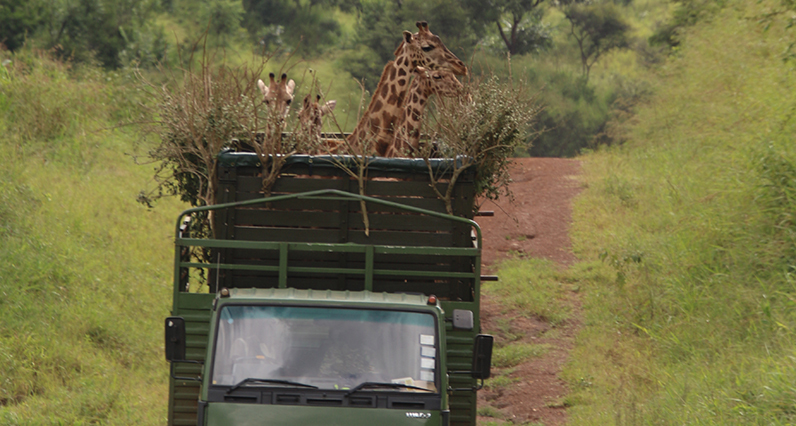Members of Cleveland's animal care staff were part of a group that relocated a herd of endangered giraffe in Africa
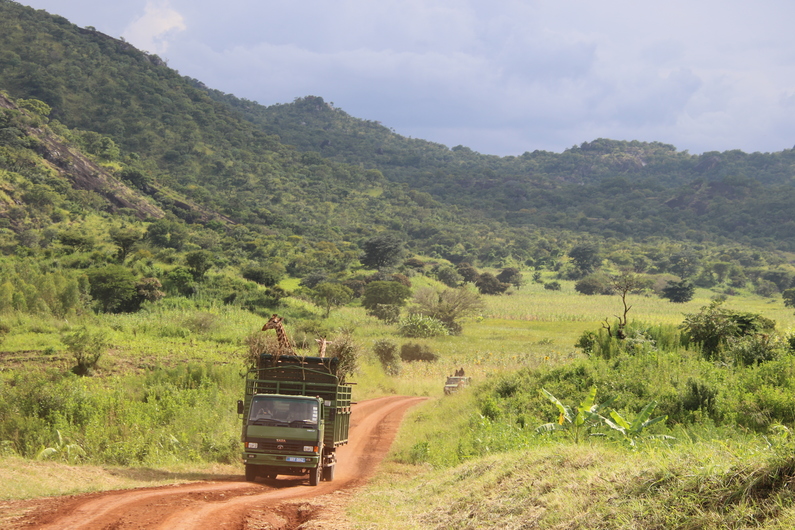 Road to Kidepo Valley National Park.
Road to Kidepo Valley National Park.
“Kidepo is Uganda’s most isolated national park, but the few who make the long journey north through the wild frontier region of Karamoja would agree that it is also the most magnificent, for Kidepo ranks among Africa’s finest wildernesses.”
The roads to Kidepo Valley National Park are not for the faint of heart. In some places, “roads” is a generous description of the rocky paths or tracks made through packed red dirt. Even the Uganda Wildlife Authority, which runs and maintains all of the country’s national parks, admits on its tourist information website that few make the “long journey north.”
But for the caravan of travelers from Operation Twiga III, the rough drive to Kidepo was a satisfying end of a three-week journey to secure a future for wildlife.
The mission
Murchison Falls, Uganda’s largest national park, is home to more than 75 species of mammals and half of the world’s wild population of Nubian giraffe, a subspecies of Northern giraffe that is listed as endangered on the IUCN Red List. Only about 2,600 individuals are left in the wild, and giraffe populations as a whole have decreased 40% in the past 15 years.
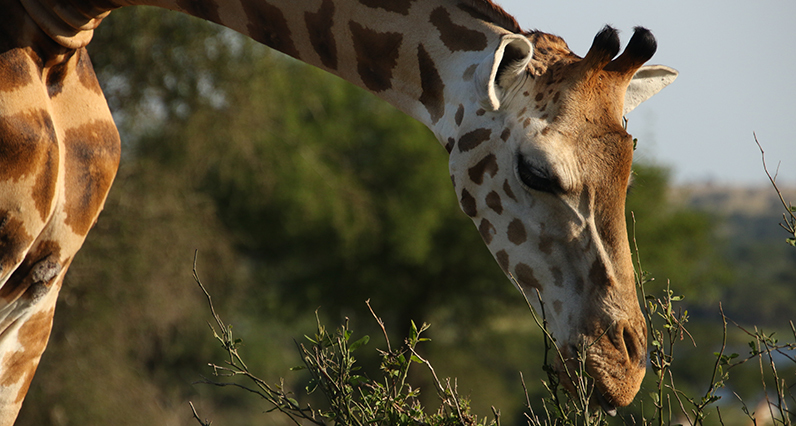
Giraffe in Murchison Falls, Uganda.
Giraffe are facing habitat loss in Murchison Falls because of oil drilling and the building of a pipeline through the park, which will begin by the end of this year.
Led by the Uganda Wildlife Authority and the Giraffe Conservation Foundation, Operation Twiga I (2016) and II (2017) relocated giraffe within the park, across the Nile River to land not affected by the drilling.
But the goal of Operation Twiga III was a bit more ambitious: Move 14 giraffe more than 250 miles across Uganda to a new home in Kidepo Valley National Park.
The operation was a group effort. Translocations and immobilizations were led by the Uganda Wildlife Authority, with technical and funding support from the Giraffe Conservation Foundation, and multiple Association of Zoos & Aquarium accredited zoos in America. Staff from Cheyenne Mountain Zoo in Colorado, Colorado State University and Cleveland Metroparks Zoo helped with the move and provided veterinary expertise.
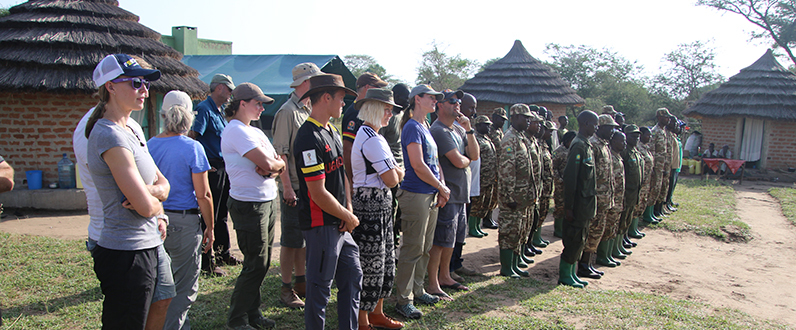
The team included groups from several organizations.
Cleveland Metroparks Zoo veterinary epidemiologist Dr. Pam Dennis has traveled extensively for the Zoo, including to Uganda for Operation Twiga II and III this August.
“Within Murchison Falls, the Nubian giraffe are concentrated on the side (of the park) they are exploring for oil, so for Twiga II, they wanted to move some from that side, across the Nile to good habitat where giraffe currently aren’t living to set up this ‘assurance population’.” - Dr. Pam Dennis, Cleveland Metroparks Zoo veterinary epidemiologist.
In addition to moving giraffe away from the threat of drilling, Operation Twiga III also bolstered the small herd in Kidepo. The park had seen its once robust giraffe population dwindle down to just three individuals in the 1980s.
There was no doubt the move would benefit giraffe populations in both parks, but there was one bit of uncertainty, said Dr. Dennis: “Kidepo had no known cases of giraffe skin disease.”
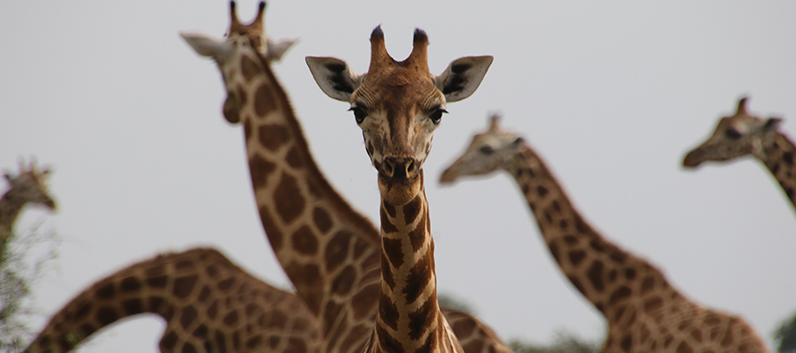
Giraffe skin disease causes lesions on the legs and neck of giraffe, and although it is becoming more widespread throughout Africa, scientists and conservationists don’t know what is causing it nor whether it is causing long-term health impacts on wild herds.
“We have many questions still about giraffe skin disease,” said Dr. Dennis, who has done field work in Africa and research in the States on the disease. “What is causing it, is it transferring from individual to individual, is it affecting overall giraffe health or is it just topical? And important for this mission was the question of can we spread it by moving giraffe, or can domestic livestock get it?”
Kidepo Valley is surrounded by villages and farms, so it would not be a good conservation move to put affected giraffe near domestic livestock if the disease were contagious. Suddenly the giraffe that were being welcomed into the new park would be seen as a threat.
Cleveland keeper Claire Winkler, who spends most of her time in the Zoo’s Africa Barn and rhino yards, also went to Uganda. Winkler played an important role monitoring the welfare of giraffe during the translocation and also working as part of the health team with Dr. Dennis and others. The health team assessed the health of the individual giraffe and collected samples in the field that would be part of larger studies of giraffe skin disease.
It was Winkler’s first trip to Africa and she was eager to observe giraffe and other African mammals, hoping to compare behavior between wild and captive herds.
“It was fabulous to see naturally happening herds of elephant, giraffe, hippos and more at Murchison Falls,” said Winkler. “And just babies everywhere! Murchison Falls has no shortage of babies of any species. To see natural herds right in front of me was very moving.” - Claire Winkler, Cleveland Metroparks Zoo keeper
The moments of gratitude — of seeing African wildlife in untouched places — would be hard earned because capturing and moving giraffes is no easy task.
The move
The group effort it takes to successfully move giraffes cannot be understated. It begins with a caravan: three trucks full of spotters, rangers, a dart team and veterinarians, plus a tractor and a trailer.
The lead truck contains a crew of experts and rangers who are looking for the right individual giraffe, as well as veterinarians who would dart the giraffe with anesthesia to begin to immobilize it.
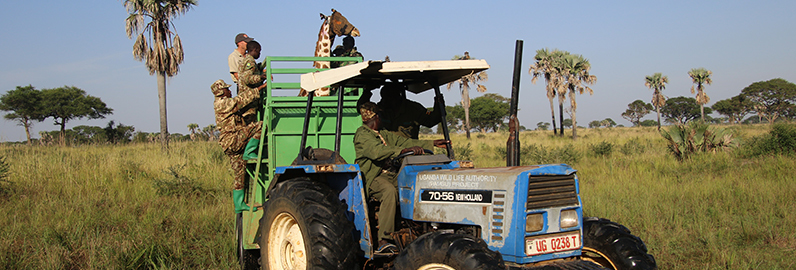
Rangers on the lookout for giraffe.
Finding the right giraffe is tricky. “You’re looking for an individual that’s old enough so you aren’t moving a nursing calf, but young enough so you aren’t moving a large adult, so you wanted the three- to four-year-old, mostly female giraffe,” said Dr. Dennis.
No small task considering the group is looking at a herd from a truck (on a rough road or no road, remember) from a distance. The decision has to be made quickly — before the herd realizes it’s being stalked — and the team has to be ready to move.
The minute the giraffe is darted, the second truckload of people, wildlife rangers who serve as the capture team, “literally jump out of the truck, run after the just-darted giraffe and get in front of it (a 14-foot tall mammal, that is) with ropes,” said Winkler. Their job is to guide the woozy giraffe to a stop and get it to lie down.
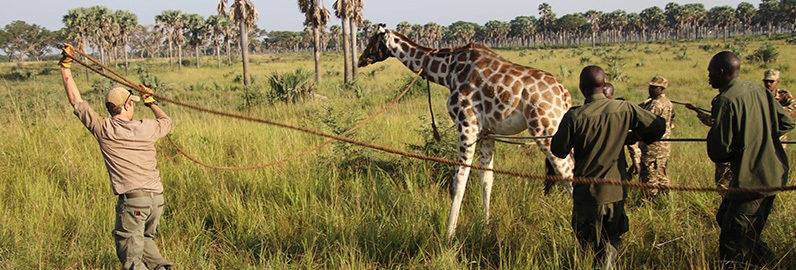
The capture team carefully immobilizing a giraffe.
Once the giraffe is immobile, those in the third truck — including Winkler and Dr. Dennis — run out to begin veterinary checks and blood tests. Winkler worked as part of the team to take hair and fecal samples, while Dr. Dennis and others performed skin biopsies of those with giraffe skin disease and took blood. Some tests were run in the field using a tiny i-stat machine; other samples were analyzed back at camp or stored for future analysis.
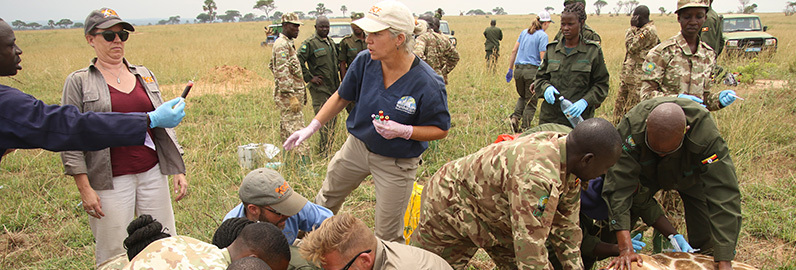
Dr. Pam Dennis, Cleveland Metroparks Zoo veterinary epidemiologist managing blood samples taken from the giraffe.
This same team has a second important job in the caravan: giving the giraffe an antidote to reverse the effects of anesthesia so it stands up and can be gently guided by rangers to the trailer (pulled by the tractor) for transport to the holding corral, or a boma.
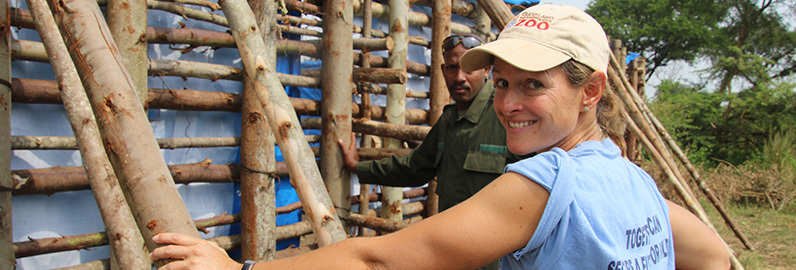 Cleveland Metroparks Zoo Animal keeper Clair Winkler monitoring the welfare of the giraffe inside the boma.
Cleveland Metroparks Zoo Animal keeper Clair Winkler monitoring the welfare of the giraffe inside the boma.
Sounds like this could process could take some time, right? Think again. The team had about 15 minutes total from darting to releasing the animal into the trailer.
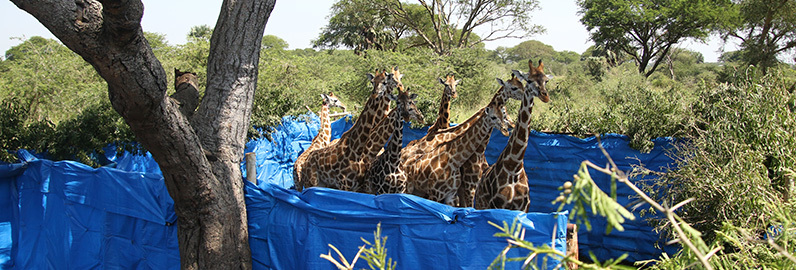
A herd of giraffe in the boma.
The giraffe were corralled together in a boma, which is a temporary structure made of logs and lined with tarp that keeps the individuals together so they can be social and take comfort in not being held alone. The quick work is necessary so the giraffe do not feel stressed, which could negatively impact the health of the individual.
“We learned from Operation Twiga II that if you’re by yourself in the boma that’s not very good,” said Dr. Dennis. “So the goal for our teams became to get the first giraffe then the second giraffe as fast as possible and continue until you have a small herd.”
So this process repeats for a few hours — finding an individual, darting it, performing veterinary tasks and guiding it to the boma — until 10 giraffe are in the boma. And then it was time to transport.
Giraffe being transported to Kidepo Valley National Park.
Once there were 10 giraffes in the boma, five were loaded into the travel truck. The giraffes’ truck is adorned with tree branches for both snacks and to keep the giraffe rather contained. But the world’s tallest mammal can’t be contained easily, so the truck looked like a children’s book come to life, with too-tall giraffe heads sticking out from the top.
The giraffe now joined the Operation Twiga III caravan — the veterinarians, the rangers, the guides (who now had the important job of spotting low-hnging trees and wires for the trucks to navigate under), and the animal care experts. They drove roughly 300 miles northeast to Kidepo Valley National Park, which borders South Sudan.
The one-way trip took almost eight hours, through roughly paved roads that turned into paths on heavy, dusty red dirt. (“It was a complete dust bath,” said Winkler.) The trucks needed to stay together so they had occasional, five minute stops for gas, food and breaks before starting out again.
The trip was not easy, but it did provide moments of joy for Dr. Dennis and Winkler.
“We would drive through towns and people would come out. We would drive by a school and kids would be out having recess and they’d all come running over,” said Dr. Dennis. “A lot of people in these towns had never seen giraffe, so they are seeing giraffe for the first time just drive by.”
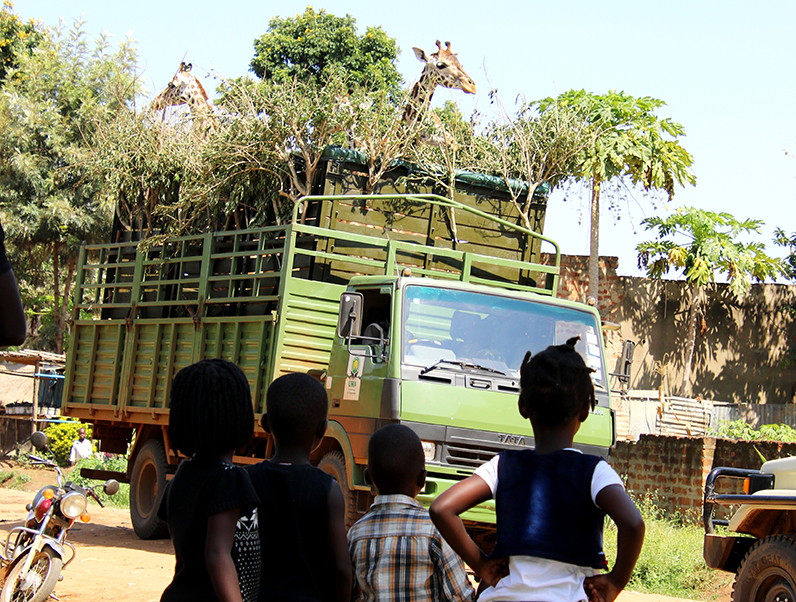
Children watch as giraffe are transported through their village.
In advance of the trip, communities bordering Kidepo got lessons from wildlife rangers on what to do if a giraffe wanders into their yards in hopes of preventing human-wildlife conflict. Because after all of this effort to bring the giraffe to safety in Kidepo, it will take a village (or two) to keep the population safe in its new home.
Overall, the mood was joyous said Winkler, especially during the release, when the Twiga team and nearby villagers experienced the giraffe running off into Kidepo Valley.
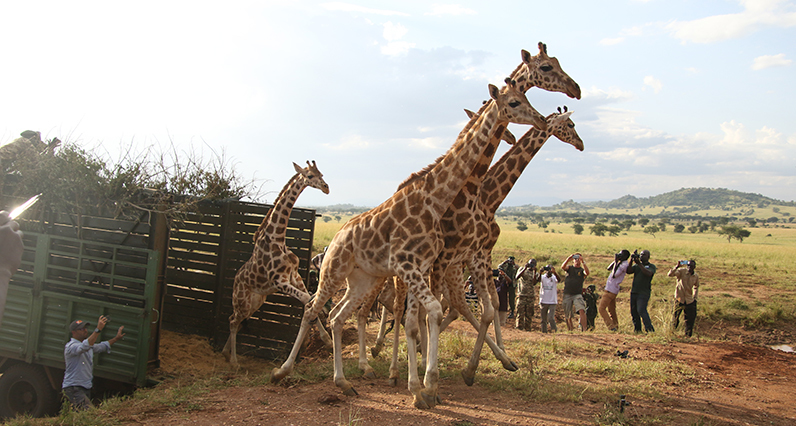
The team watches as giraffe are successfully released in Kidepo.
“So many people were excited to see us arrive,” said Winkler. “This woman came right up to me and said ‘Thank you for bringing the giraffe, thank you for bringing the giraffe!’ It was very emotional at times.”
Transporting the 14 giraffe took a total of five days, with three trips back and forth between Murchison Falls and Kidepo. The impact on the giraffe population is major, but the project also had a lasting impact on Winkler and Dr. Dennis.
“The trip was really a three week high,” said Winkler. “You could talk just giraffe all day long and not feel like a nerd! It was such an amazing crew, and I still feel very tied to them. They were all so smart and so motivated. I would work with them on a daily basis.”
The Twiga team is on a group text chain, where members share updates from throughout their parts of the world - Africa, America, Australia and places in between. The friendship and collaboration continues, which is part of the vital conservation work happening around the world said Dr. Dennis.
“We need to continue to try to maximize what we can all do together,” she Dr. Dennis. “We need to take the expertise that we have here in zoos and use it in the wild and vice versa. No one needs to reinvent the wheel, we just need to put the right wheels on the right machine.”

Operation Twiga III team after transporting 14 giraffe more than 250 miles across Uganda to a new home in Kidepo Valley National Park.
Giraffe Release Clip: Operation Twiga 3 - 2018
Watch a video of the transport
Transporting a giraffe to the boma: Operation Twiga 3 - 2018
PHOTO CREDITS: Thank you to Michael Butler Brown, a doctoral student from Dartmouth College's Department of Ecology and Evolutionary Biology, who spent many months studying population ecology with the Giraffe Conservation Foundation.
Giraffe SAFE
Read more about giraffe as a SAFE (Saving Animals From Extinction) species.



